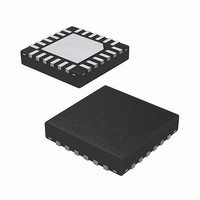ISL97645AIRZ-T Intersil, ISL97645AIRZ-T Datasheet - Page 12

ISL97645AIRZ-T
Manufacturer Part Number
ISL97645AIRZ-T
Description
IC REG BOOST VON VCOM 24-QFN
Manufacturer
Intersil
Datasheet
1.ISL97645IRZ-TK.pdf
(16 pages)
Specifications of ISL97645AIRZ-T
Applications
LCD Monitor, Notebook Display
Current - Supply
1mA
Voltage - Supply
2.7 V ~ 5.5 V
Operating Temperature
-40°C ~ 85°C
Mounting Type
Surface Mount
Package / Case
24-QFN
Lead Free Status / RoHS Status
Lead free / RoHS Compliant
Supply Monitor Circuit
The Supply Monitor circuit monitors the voltage on VDIV,
and sets open-drain output RESET low when VDIV is below
1.15V (rising) or 1.1V (falling).
There is a delay on the rising edge, controlled by a capacitor
on CD2. When VDIV exceeds 1.15V (rising), CD2 is charged
up from 0V to 1.215V by a 10µA current source. Once CD2
exceeds 1.215V, RESET will go tri-state. When VDIV falls
below 1.1V, RESET will become low with a 750 pull-down
resistance. The delay time is controlled by Equation 7:
For example, the delay time is 12.15ms if the CD2 = 100nF.
Figure 15 is the Supply Monitor Circuit timing diagram.
t
VDIV
delay
FIGURE 15. SUPPLY MONITOR CIRCUIT TIMING DIAGRAM
RESET
=
CD2
121.5k CD2
×
RESET DELAY TIME IS
CONTROLLED BY CD2
CAPACITOR
1.215V
12
(EQ. 7)
1.1V
1.15V
ISL97645A
Gate Pulse Modulator Circuit
The gate pulse modulator circuit functions as a three way
multiplexer, switching VGHM between ground, VDD1 and
VGH. Voltage selection is provided by digital inputs VDPM
(enable) and VFLK (control). High to low delay and slew
control is provided by external components on pins CE and
RE, respectively. A block diagram of the gate pulse
modulator circuit is shown in Figure 16.
When VDPM is LOW, the block is disabled and VGHM is
grounded. When the input voltage exceeds UVLO threshold,
VDPM starts to drive an external capacitor with 20μA. Once
VDPM exceeds 1.215V, the GPM circuit is enabled, and the
output VGH_M is determined by VFLK, RESET signal and
VGH voltage. If RESET signal is high, and when VFLK goes
high, VGHM is pulled to VGH by a 70Ω switch. When VFLK
goes low, there is a delay controlled by capacitor CE,
following which VGHM is driven to VDD1, with a slew rate
controlled by resistor RE. Note that VDD1 is used only as a
reference voltage for an amplifier, thus does not have to
source or sink a significant DC current.
Low to high transition is determined primarily by the switch
resistance and the external capacitive load. High to low
transition is more complex. Take the case where the block is
already enabled (VDPM is H). When VFLK is H, pin CE is
grounded. On the falling edge of VFLK, a current is passed
into pin CE, to charge an external capacitor to 1.2V. This
creates a delay, equal to CE*4200. At this point, the output
begins to pull down from VGH to VDD1. The slew current is
equal to 300/(RE + 5000), and the dv/dt slew rate is
Isl/C
where C
When RESET signal changes to low, and VGH voltage is
above 2.5V, the VGH_M will be tied to VGH voltage until the
VGH voltage falls down to 2.5V. If the VGH voltage is lower
than 2.5V, GPM block will not work properly, and there is no
active control for VGH_M output. The following table shows
the VGH_M status based on V
LOAD
LOAD
.
is the load capacitance applied to VGHM.
IN
, VGH and RESET:
October 21, 2010
FN6353.1







